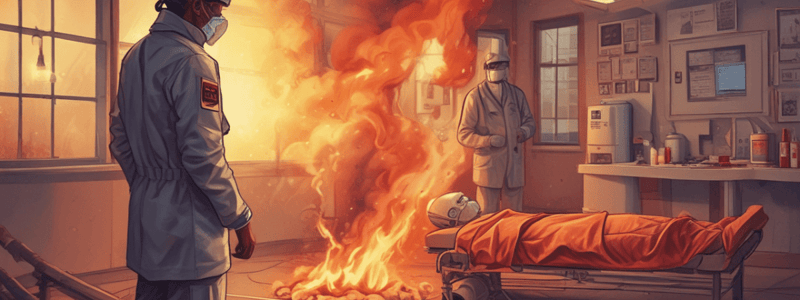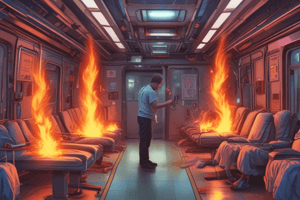Podcast
Questions and Answers
What is a key consideration when assessing the burn area?
What is a key consideration when assessing the burn area?
- The weight of the patient
- The surface area involved (correct)
- The age of the patient
- The medical history of the patient
Why may it be necessary to remove loose epidermal layers when assessing pigmented skin?
Why may it be necessary to remove loose epidermal layers when assessing pigmented skin?
- To calculate burn size (correct)
- To assess the patient's age
- To determine the patient's medical history
- To calculate burn depth
What is the percentage of TBSA that warrants formal resuscitation in children?
What is the percentage of TBSA that warrants formal resuscitation in children?
- More than 10% (correct)
- 15% or less
- 10% or less
- 20% or more
What is the starting point for calculating fluid resuscitation using the Parkland's formula?
What is the starting point for calculating fluid resuscitation using the Parkland's formula?
Which of the following patient groups require extra fluid requirements?
Which of the following patient groups require extra fluid requirements?
What is the purpose of continuously adjusting fluid resuscitation regimens?
What is the purpose of continuously adjusting fluid resuscitation regimens?
What is the primary goal of in-hospital care for burn patients?
What is the primary goal of in-hospital care for burn patients?
Which of the following is not an option for skin cover in burn patients?
Which of the following is not an option for skin cover in burn patients?
When is care considered 'futile' for burn patients?
When is care considered 'futile' for burn patients?
What is the primary role of a social worker in burn patient rehabilitation?
What is the primary role of a social worker in burn patient rehabilitation?
What is the recommended wound coverage for burn patients during transfer?
What is the recommended wound coverage for burn patients during transfer?
What is the primary goal of early mobilization in burn patient rehabilitation?
What is the primary goal of early mobilization in burn patient rehabilitation?
What is a critical aspect of exposure in the primary survey of a burn patient?
What is a critical aspect of exposure in the primary survey of a burn patient?
What percentage of Total Body Surface Area (TBSA) burn requires a urinary catheter?
What percentage of Total Body Surface Area (TBSA) burn requires a urinary catheter?
When calculating burn area, what should be excluded?
When calculating burn area, what should be excluded?
What is the surface area of a patient's palm, including fingers, roughly equivalent to?
What is the surface area of a patient's palm, including fingers, roughly equivalent to?
What method of estimating burn area is quick and suitable for large burns in adults?
What method of estimating burn area is quick and suitable for large burns in adults?
What is the most accurate method of assessing burn area, if used correctly?
What is the most accurate method of assessing burn area, if used correctly?
What is important to do when assessing the burn area?
What is important to do when assessing the burn area?
What is a critical aspect of analgesia in burn patients?
What is a critical aspect of analgesia in burn patients?
What type of energy can cause burns?
What type of energy can cause burns?
What is the primary focus of the initial assessment of a major burn?
What is the primary focus of the initial assessment of a major burn?
What is a sign of inhalational injury?
What is a sign of inhalational injury?
When should intubation be considered in a burn patient?
When should intubation be considered in a burn patient?
What is a complication of mechanical restriction of breathing in burn patients?
What is a complication of mechanical restriction of breathing in burn patients?
What is the effect of carboxyhaemoglobin on the body?
What is the effect of carboxyhaemoglobin on the body?
When should a burn patient be ventilated?
When should a burn patient be ventilated?
What is a indication for ventilation in a burn patient?
What is a indication for ventilation in a burn patient?
What is the primary focus of the 'C' component of the primary survey in a burn patient?
What is the primary focus of the 'C' component of the primary survey in a burn patient?
What should be administered to all burn patients?
What should be administered to all burn patients?
Flashcards are hidden until you start studying
Study Notes
Management of a Burn – Assessment, Resuscitation & Rehabilitation
Causes of Burns
- Thermal energy
- Electrical energy
- Chemical (acid or alkaline)
Initial Assessment of a Major Burn
Primary Survey
- Modified ATLS primary survey
- Emphasis on airway and breathing assessment
- Serious associated injuries may be missed if not followed sequentially
Airway with C Spine Control
- Compromised or at risk of compromise
- Signs of inhalational injury:
- History of flame burns or burns in an enclosed space
- Deep dermal or full thickness burns to face, neck, or upper torso
- Singed nasal hair
- Carbonaceous sputum or carbon particles in oropharynx
Indications for Intubation
- Erythema or swelling of oropharynx on direct visualisation
- Change in voice, with hoarseness or harsh cough
- Stridor, tachypnoea, or dyspnoea
Breathing
- All burn patients should receive humidified oxygen via a non-rebreathing mask
- Compromise can occur via:
- Mechanical restriction of breathing (deep dermal or full thickness circumferential burns of the chest)
- Blast injury (blast lung, lung contusions, alveolar trauma, and pneumothoraces)
- Smoke inhalation (products of combustion act as direct irritants, leading to bronchospasm, inflammation, bronchorrhoea, and impaired ciliary action)
Circulation
- Establish IV access with 2 large bore cannulas, preferably through unburnt skin
- Profound hypovolaemia is not the normal initial response to a burn
Neurological Disability
- Assess GCS
- Confusion ?Hypoxia or hypovolaemia
Exposure with Environmental Control
- Fully assess burn area and depth
- Check for concomitant injuries
- Keep warm – burn patients easily become hypothermic, leading to hypoperfusion and deepening of burn wounds
Fluid Resuscitation
- Using guidelines
- Urinary catheter mandatory in burns >20% TBSA
Analgesia
- All patients with large burns should receive IV morphine, titrated against pain and respiratory depression
Assessment of Burn Area
Methods of Estimating Burn Area
- Palmar surface (roughly 1% TBSA)
- Wallace's rule of nines (quick way of estimating large burns in adults)
- Lund and Browder chart (most accurate method, compensates for variation in body shape with age)
Important Considerations
- Erythema should not be included when calculating burn area
- Use a warm environment and sequentially expose small segments of skin to reduce heat loss
- Pigmented skin can be difficult to assess; may need to remove loose epidermal layers to calculate burn size
Resuscitation
Fluid Resuscitation Regimens
- The Parkland formula is commonly used
- The starting point is the time of injury, not time of admission
- Certain patient groups require extra fluid requirements (children, inhalational injury, electrical injury, delayed resuscitation, and dehydration or intoxicated patients)
Transfer and Care
Who to Transfer
- Adults: >10% full thickness, >20% deep partial, flexors, perineum, inhalation, head and neck
- Children: >5% full thickness, >10% deep partial (Red Cross Hospital)
When Care is "Futile"
- >60% full thickness with inhalation
- >70% full thickness without inhalation
- >80% deep partial
- What to do:
- Secure airway (don't ventilate)
- Adequate analgesia (IV)
- Catheter
- Counsel family and call spiritual leader
In-Hospital Care
Prevention of Sepsis
- Cover with silver-containing cream
- Debride blisters
- Resuscitate
- Early enteral feeding
- Early excision and biological wound coverage
Skin Cover Options
- Autologous split skin grafts
- Living related donors
- Cadaver skin
- Synthetic analogues (expensive)
- Xenografts (pig and frog)
- 20% BSA per sitting
- Tissue biopsy for MCS
Rehabilitation: A Team Effort
Early Phase
- Chest physio
- Early mobilisation
- Post-graft splinting
- ADL adaptation
- Compression garments and dynamic hand splints (OT later phase)
Multidisciplinary Team
- Social Worker
- Psychologist
- Dietician
- Pastor / Imam / Rabbi
- Family and community
- Reconstructive (plastic) surgeon
Studying That Suits You
Use AI to generate personalized quizzes and flashcards to suit your learning preferences.




